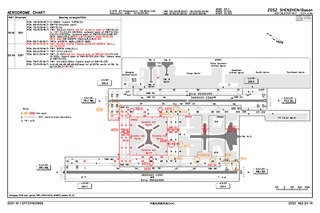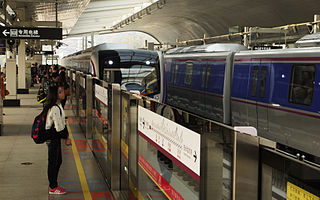
Guangzhou, also known as Canton and alternately romanized as Kwangchow, is the capital and most populous city of the province of Guangdong in southern China. Located on the Pearl River about 120 km (75 mi) north-northwest of Hong Kong and 145 km (90 mi) north of Macau, Guangzhou has a history of over 2,200 years and was a major terminus of the maritime Silk Road, and continues to serve as a major port and transportation hub, as well as one of China's three largest cities. Long the only Chinese port accessible to most foreign traders, Guangzhou was captured by the British during the First Opium War. No longer enjoying a monopoly after the war, it lost trade to other ports such as Hong Kong and Shanghai, but continued to serve as a major transshipment port. Due to a high urban population and large volumes of port traffic, Guangzhou is classified as a Large-Port Megacity, the largest type of port-city in the world.

The Guangzhou Metro is the rapid transit system of the city of Guangzhou in Guangdong Province of China. It is operated by the state-owned Guangzhou Metro Corporation and was the fourth metro system to be built in mainland China, after those of Beijing, Tianjin, and Shanghai.

Shunde District, also known as Shuntak, is a former district of the city of Foshan, Guangdong province, located in the Pearl River Delta. Once a traditional agricultural county, it has become one of the most affluent counties in Guangdong and mainland China. Since 2009 it has been administrated independently of Foshan city, answerable directly to the Guangdong provincial government.

Shenzhen Bao'an International Airport is the airport serving Shenzhen, Guangdong Province. It is located on the east bank of the Pearl River near Huangtian and Fuyong villages in Bao'an District, and is 32 km (20 mi) northwest of the city center. It is a hub for Shenzhen Airlines and Shenzhen Donghai Airlines and for cargo airline SF Airlines, and a focus city for China Southern Airlines and Hainan Airlines. The airport also serves as an Asian-Pacific cargo hub for UPS Airlines. The airport is undergoing major expansions with a second runway completed and opened in 2011 and a new terminal which opened in 2013.

Gu Yanwu, also known as Gu Tinglin, was a Chinese philologist, geographer, and famous scholar-official in Qing dynasty. He spent his youth during the Manchu conquest of China in anti-Manchu activities after the Ming dynasty had been overthrown. He never served the Qing dynasty. Instead, he traveled throughout the country and devoted himself to studies.

Maiji District is a district of the prefecture-level city of Tianshui in the southeast of Gansu Province, China, bordering Shaanxi Province to the east. It is best known for the Maijishan Grottoes. Before 2005 it was called Beidao District.

Dongcheng Subdistrict is one of the four subdistricts of Dongguan, Guangdong Province, China. The subdistrict has an area of 105.9 square kilometers, and, as of 2019, has a permanent population of around 500,000, and a registered population of around 99,500. Dongcheng Subdistrict's GDP as of 2019 is ¥58.656 billion.

Qingcheng is a district of Qingyuan, Guangdong province, China.

Shiling is a town in Huadu District, Guangzhou. In the 1970s the government began centrally planned industrialization of Shiling as a leatherworking town. The town is now a major center for the leatherworking industry in China. The town spans an area of 136.31 square kilometers, and is home to 300,000 residents.
Wong Lo Kat or Wanglaoji in Mandarin pinyin, is an Chinese herbal tea, and one of the most popular tea drinks in China today. It is sold in many forms and different types of cans or cardboard containers.

Line 8 of the Guangzhou Metro is a north-west L-shaped line on the system that runs from Jiaoxin to Wanshengwei, spanning a total of 33.9 km (21.1 mi) with 26 stations. It interchanges with Line 1 at Chen Clan Academy, Line 2 at Changgang, Line 3 at Kecun, Line 4 at Wanshengwei and Line 6 at Cultural Park. All stations on Line 8 are underground. Line 8's color is teal.

Line 6 of the Guangzhou Metro runs from Liwan District to Huangpu District. It starts at Xunfenggang and ends at Xiangxue, interchanging with Line 5 at Tanwei and Ouzhuang; Line 1 at Huangsha and Dongshankou; Line 8 at Cultural Park; Line 2 at Haizhu Square; Line 21 at Suyuan; Line 3 at Yantang and Tianhe Coach Terminal. The total length is 41.9 km (26.0 mi) with 32 stations. Line 6 serves densely populated areas including residential communities in Jinshazhou, the pedestrian street in Beijing Lu and wholesale markets in Shahe. Nevertheless, Line 6, which runs four-car trains, has long had a questionable train capacity. The phase one section between Xunfenggang and Changban began to provide service from 28 December 2013 with the exception of Yide Lu and Shahe stations. Yide Lu opened over a year later on 28 January 2015. The second phase of Line 6 from Changban to Xiangxue has been in operation since 28 December 2016. Like Lines 4 and 5, Line 6 is equipped with linear induction motor technology. Line 6's color is maroon

Guangzhou No.2 High School is a Chinese public high school in Guangzhou, Guangdong. The school was established in August, 1930.

Guangzhou–Shenzhen intercity railway or Suishen intercity railway is a commuter railway in the Pearl River Delta of Guangdong, China. The construction route traces roughly along the east bank of the Pearl River, connecting Guangzhou, Dongguan and Shenzhen Bao'an International Airport. It will feature a length of 73.996 km from Xintang South to Shenzhen Airport, operating at a top speed of 140 km/h using CRH6A trains.

Tu Dongxu is a Chinese footballer who plays for China League One side Kunshan FC.

The Legend of Five Goats comes from the ancient Guangzhou city, and is an origin of Guangzhou's nicknames like 'City of Five Goats', 'City of the Goat', 'City of the Rice'. It is also the origin of many Guangzhou local brands' names. The name 'Five Goats' can earliest be seen in poetry of Tang dynasty, and the related legendry can be dated back to Jin dynasty. Though the legendary had several versions, it was unified after Ming dynasty. Usually the Legend of Five Goats reflects the history that Lingnan people was colonized by Zhongyuan ancestors. In 2007, this legend was collected into the first batch of The Masterpieces of the Oral and Intangible Heritage of Humanity of Guangzhou.

Dongshankou is an area in the Yuexiu District of Guangzhou, Guangdong province, People's Republic of China. The name "Dongshan" can trace back to Ming Dynasty. An eunuch named Wei Juan, who was an officer in Guangzhou in years of Chenghua of Ming Dynasty, built a temple on a small hill in the east side of Guangzhou city to boast himself. Guangzhou people at that time often called the main small hill as "Shan" and called the hummocks around it as "Gang", so they named the temple "Dongshan Temple". After that, the surrounding area is called Dongshan.
Liang Jingkang, also known as Leon Leong, formerly Connor Leong, is a Chinese actor and model. He is best known for his role as Feng Meizuo in the television series Meteor Garden (2018), which propelled him to fame in China and Asia.
Mole Manor is a massive multiplayer online (MMO) game targeted at children ages 6 to 14; there is, however, no specific age or gender restriction on the game. The game was inspired by the online platform Club Penguin, where players can choose cartoon mole-avatars, decorate their virtual homes, adopt pets, and socialize with other players. They can wander through the virtual streets, chat with other users, go shopping, work, and play mini-games.

















